乔姆斯基 普遍语法 5阶段
5乔姆斯基普遍语法(中语学院:唐启萍)
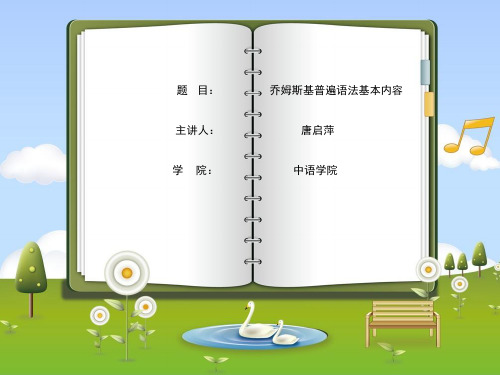
乔姆斯基普遍语法基本内容
主讲人:
唐启萍
学
院:
中语学院
1.作者简介 五、乔姆斯基普遍语法基本内容
乔姆斯基:1928年12月出生在美
1.作者简介 2.乔姆斯基普遍语法哲学渊源 3.乔姆斯基普遍语法简介
3.1 乔姆斯基普遍语法的含义 3.2 乔姆斯基理论的发展过程 3.3 乔姆斯基普遍语法理论的主 要内容
即个别语法,它是人们通过学习后天得到的。以普遍语
法为基础,以经验为外因条件,人们就能获得完整的语 法知识。
(王远新:语言理论与语言学方法论[M],教育科学出版社,2006 年8月第1版。p254)
4.2 普遍语法与个别语法
“普遍语法”是一个原则系统,它是通过规定个别语法如何 组成、这些组成部分的种种规则如何建立、它们又如何相互作用 来刻画各类可能语法的特性。 个别语法包括改写规则、转换规则、词汇规则、语义解释和 音位解释规则。
3.1.3 乔姆斯基普遍语法的含义
普遍语法是乔姆斯基语言学理论中的科学术语,他本人多次界定普遍语法的含义。
乔姆斯基在《管约论》中认为:普遍语法由两大系统组成:规则系统和原则系统。原则系 统又由若干子系统构成,这些子系统包括X标杆理论、论旨理论、格理论、管辖理论、约束理论、 控制理论和界限理论等,每个子系统均含有各种语言所共有的普遍原则,以及在原则范围之内
国费城的一个犹太人家庭,父亲是希 伯来语学者。在宾夕法尼亚大学期间, 乔姆斯基主要学习语言学、数学、哲 学和逻辑学。从1947年开始,他专攻 语言学;1951年完成硕士学位论文 《现代希伯来语的语素音位学》; 1955年,完成博士学位论文《转换分 析》,并于同年秋季进入麻省理工学 院任教至今。
——王远新《语言学理论与语言学方法论》
第四阶段:转换生成语言学阶段Microsoft Word 文档
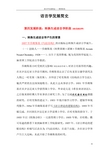
语言学发展简史第四发展阶段:转换生成语言学阶段(形式语言学)一、转换生成语言学产生的背景1957年乔姆斯基《句法结构》的出版标志转换生成语言学诞生。
(一)创始人——乔姆斯基(阿费莱姆·诺姆·乔姆斯基Avram Noam Chomsky,1928——),出生于美国费城,现为美国科学院院士,麻省理工学院语言学教授。
乔姆斯基小时受到其父影响(希伯来语学者),对语言有浓厚的兴趣。
在宾夕法尼亚大学读书期间,乔姆斯基认识了后布龙菲尔德学派代表人物之一哈里斯(海里斯),并拜读了哈里斯的《结构语言学方法》,被其严密的方法深深地吸引,从此立志从事语言学。
1951年乔姆斯基在宾夕法尼亚大学获得硕士学位,毕业论文是《希伯来语语法》。
之后他来到哈佛大学从事语言研究工作,为了完成形式语言理论课题的研究,在哈里斯的建议下,1953年他开始学习哲学、逻辑学和现代数学。
1954年乔姆斯基着手写《语言理论的逻辑结构》,1955年书稿完成,并回到宾夕法尼亚大学读博士学位,在哈里斯的指导下,于1955年以《转换分析》一文获得博士学位。
1955年秋,在哈勒、雅可布逊的推荐下来到麻省理工学院做研究。
1957年,《语言理论的逻辑结构》经缩写后改名为《句法结构》,在荷兰出版,并在语言学界产生巨大反响。
从此开始了乔姆斯基的时代。
(二)乔姆斯基的语言哲学基础乔姆斯基声称自己的语言理论的基础是笛卡尔的理性主义哲学。
人类的理性和思维是一致的,语言是用来表达思想的,因此本质上是一致的,表面形式的不同只是同一个体系的变体。
多样形式(语音、字母)这些符号的存在,是为了人们表达思想的需要而已。
(参见第一阶段,彭p356--357)(三)乔姆斯基的语言理论基础乔姆斯基声称自己的语言理论直接来源于阿尔诺(A.Arnauld)、朗斯洛(ncelot)的《普遍唯理语法》和德国政治家、语言学家洪堡特(Karl Wilhelm von Humboldt,1767----1835)的理论。
谈乔姆斯基的“最简方案”
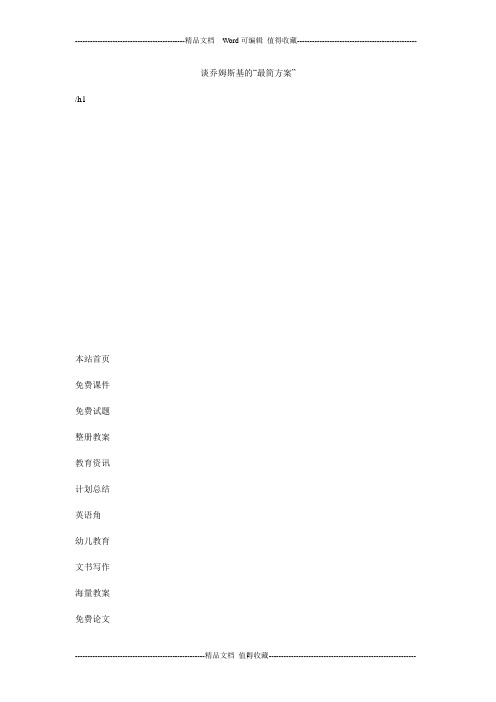
医学论文
文史论文
农科论文
英语论文
课程改革
教育法规
教育管理
家长频道
您现在的位置:3edu教育网免费论文英语论文英美文学正文3edu教育网,百万资源,完全免费,无需注册,天天更新!
谈乔姆斯基的“最简方案”
一、“最简方案”的形成转换生成语法作为当今语言学界最有影响的两大理论之一,是由美国语言学家乔姆斯基于20世纪50年代末开始创立的。五十多年来,经过乔姆斯基及其追随者不懈的研究与发展,转换生成语法主要经过了五个阶段的演变:1)古典理论阶段2)标准理论阶段3)扩展的标准理论阶段4)管辖与约束理论阶段5)最简方案阶段。古典理论阶段的主要特色是生成和转换,语义是被排斥在语法之外的。标准理论阶段引进了语义,提出了“深层结构”和“表层结构”,转换规则只改变句子的结构,句子的意义是由“深层结构”决定的。扩展的标准理论阶段认为转换不仅改变句子的结构,也改变句义;这一时期把语义放在词库中,开始执行“宽进严出”的理论构想,从规则系统转引到原则系统,使其理论具有更高程度的概括性。管辖与约束理论阶段提出了UG由“原则”和“参数”组成,“原则”表明人类语言的共性,“参数”表明人类语言的个性;语法具有组合性,UG由相互作用的子系统构成;这一阶段所有理论的设立都是以英语为基础的,研究多集中于使用种种规则来限制生成语法的生成能力,把种种不合格的句子排除在外,过分地看重了语言间的差异,最终使得“参数”多得失去了控制,失去了普遍语法的意义。1992年至今被称为最简方案阶段,代表作是《语言学理论最简方案》。最简方案起初汇集了80年代各种研究的结果,这些研究在开始的时候大多旨在修补管约论中某些具体的方面,但随着修补的越来越多,原有的框架已大为变化,产生了新的方案。乔姆斯基试图建立的是最简的句法,因而新方案放弃了“深层结构”、“表层结构”、X-杠理论、管辖理论等,恢复了转换生成语法早期的“宽式转换”。具体而言,其操作模式是:先在词库中选择合适的词语,然后进行运算(运算的主要方式是合并和移动),并在一定的时候进行“显形”,再次就是分离,分别进入语音表达式和逻辑表达式。二、“最简方案”之我看作为“原则与参数理论”的第二阶段,最简方案相对管约论有了一些显着的变化,将其中为了进行句法描述且保持理论内部一致引进的很多概念降低到了最低限度,只由必不可少的因素组成。(一)“最简方案”的进步之处最简方案是乔姆斯基为建立“完美的句法理论”而提出来的,同前几个时期相比,它有许多自身的进步之处。首先,最简方案简化了语法系统的构成,认为任何语法系统都只有语音形式和逻辑形式,分别代表发声-感知系统和概念-意向系统。其次,最简方案大大简化了句法运作的过程,将之分为一个数据型的词库和一个“计算系统”两部分,并以经济性原则为主导,以“简化”后的系统为核心框架,是语言机制完美性和简洁性的具体所在。乔姆斯基对最简方案的探索和改进代表着转换生成语法的最新动向,也代表着乔姆斯基追求极度概括又极度简单的完美句法的决心。(二)“最简方案”的局限性对于最简方案,乔姆斯基并不以“理论”名之,因为他认为自己的新探索还未成熟到可以名之为理论的地步。在某种程度上来说,最简方案还大多停留在高屋建瓴式的设想层面,而没有对具体的语法现象进行细致研究。为追求简单而完美的句法,乔姆斯基扩大了作为基础的词库,把诸如形态等原属语法的东西以及其它一些在句法中难以解决的东西统统放进词库,从而造成了“大词库,小句法”的局面。在最简方案中,“计算系统”运作的主要方式是合并和移动,移动的驱动力来自特征核查。如果吸引某语类的特征强,则该语类移动至能够核查该强特征的位置,此为显性移动,如果特征较弱,不足以吸引一个语类离开原来的位置,则不发生显性移动,而只出现特征的一致匹配。但是,判断特征强弱的标准从何而来,有何普遍语法意义上的理据性,是否适用于世界上所有的语言?对于这些问题,最简方案没能给出一个合理的回答,它所做的只是对某些语言呈现出的某些特征进行解释,而没有从本质上揭示出为什么这些语言会呈现出这些特征,另一些语言却没有这些特征。如果说是参数的不同导致了特征的不同,那移动就不是普遍语法所必需的了,一套精确的科学理论要求“如无必要,勿增实体”,移动因此就失去了存在于最简方案中的必要性了。还有,所谓移动过程中必须遵守的几条经济原则(如自利原则、最短距离原则、无奈原则等)是否完全地科学合理?如果其中两个或三个原则之间发生矛盾应该怎样处理?这些都是最简方案亟待解决的问题。前面提到,最简方案放弃了X-杠理论,但仔细研究其运作模式会发现,最简方案放弃的只是X-杠理论之名,其图式作为一种普遍性结构仍在词库和运算系统之间发挥着中介投射作用。遗憾的是,X-杠图示过分偏向语言的线性描写,且过多依赖语义因素,比如说附加语,它不是中心语要必然选择的,因此不是构成短语的充要条件,那它为什么要附加于XP之内而不是之外呢?再说补足语,它位于中心语的姐妹节点,无论从句法关系还是语义关系上讲都是离中心语最近的,因此是构成短语的必要成分,那为什么a lovely girl的补足语lovely缺失未造成该短语在句法上的不完整呢?对于上述问题,已有学者提出了XP+的分析方法,但不管怎样,正是因为这些问题的存在,导致了很多矛盾与冗余之处,最终引起了该理论体系的崩解。三、结语乔姆斯基的最简方案为语言学理论建设提供了“简洁雅致”这一指导性原则,使转换生成语法在这一时期达到了形式化的顶峰,但因为仍处于原则理论阶段,且原则理论中又有诸多不合理之处,如此庞大的词库,如此精简的原则,尚无法在各个不同的语言中进行实际的操作,所以,优化最简方案依旧任重而道远。参考文献:石毓智.对乔姆斯基语言学科学性的质疑—回应王强和Chomsky的批评.外国语,2006 (4),47-56.赵彦春,赵春生. X-bar之弊—从名物化分析到最简方案.当代外语研究,2010(12),25-32.
乔姆斯基转换生成语法的发展阶段

乔姆斯基转换生成语法的发展阶段乔姆斯基转换生成语法(Chomsky Normal Form)的发展经历了以下几个阶段:
1.乔姆斯基(Chomsky)在1956年提出了乔姆斯基体系(Chomsky Hierarchy)的划分,将形式语言分为四个层次:正规语言、上下文无关语言、上下文相关语言和递归可枚举语言。
乔姆斯基体系为后续的语法理论和形式语言研究奠定了基础。
2.在1956年,乔姆斯基还提出了乔姆斯基文法(Chomsky Grammar)的概念,它是上下文无关文法(Context-Free Grammar)最简单和最常用的一种类型。
乔姆斯基文法的规则形式为A -> α,其中A是非终结符,α是由非终结符和终结符组成的符号串。
3.在1957年,乔姆斯基又进一步推广了上下文无关文法的正规形式,提出了边界上下文无关文法(Bounded Context-Free Grammar)的概念。
这是一种更严格的文法形式,它限制了上下文无关文法中规则的形式,使得文法生成的语言更加简洁和规范。
4.在1963年,乔姆斯基引入了乔姆斯基范式(Chomsky Normal Form),一种更加严格的上下文无关文法形式。
乔姆斯基范式的主要特点是所有规则形式都是非终结符推导两个非终结符,或者非终结符推导一个终结符。
乔姆斯基转换生成语法的发展体现了对形式语言和语法理论的不断研究和发展。
在今天,乔姆斯基转换生成语法被广泛应用于自然语言处理、编译器设计等领域,成为了现代计算机科学中重要的工具和理论基础。
同时,基于乔姆斯基转换生成语法的扩展和改进也在不断进行中,以适应更多复杂的语言和语法现象的处理需求。
乔姆斯基
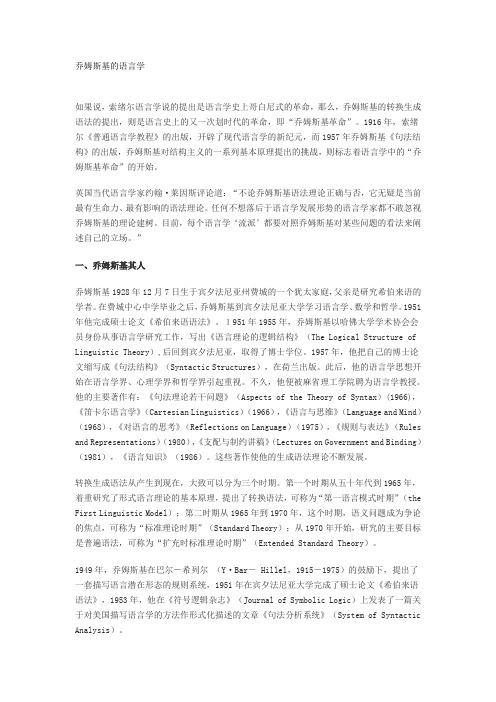
乔姆斯基的语言学如果说,索绪尔语言学说的提出是语言学史上哥白尼式的革命,那么,乔姆斯基的转换生成语法的提出,则是语言史上的又一次划时代的革命,即“乔姆斯基革命”。
1916年,索绪尔《普通语言学教程》的出版,开辟了现代语言学的新纪元,而1957年乔姆斯基《句法结构》的出版,乔姆斯基对结构主义的一系列基本原理提出的挑战,则标志着语言学中的“乔姆斯基革命”的开始。
英国当代语言学家约翰·莱因斯评论道:“不论乔姆斯基语法理论正确与否,它无疑是当前最有生命力、最有影响的语法理论。
任何不想落后于语言学发展形势的语言学家都不敢忽视乔姆斯基的理论建树。
目前,每个语言学‘流派’都要对照乔姆斯基对某些问题的看法来阐述自己的立场。
”一、乔姆斯基其人乔姆斯基1928年12月7日生于宾夕法尼亚州费城的一个犹太家庭,父亲是研究希伯来语的学者。
在费城中心中学毕业之后,乔姆斯基到宾夕法尼亚大学学习语言学、数学和哲学。
1951年他完成硕士论文《希伯来语语法》。
1951年1955年,乔姆斯基以哈佛大学学术协会会员身份从事语言学研究工作,写出《语言理论的逻辑结构》(The Logical Structure of Linguistic Theory),后回到宾夕法尼亚,取得了博士学位。
1957年,他把自己的博士论文缩写成《句法结构》(Syntactic Structures),在荷兰出版。
此后,他的语言学思想开始在语言学界、心理学界和哲学界引起重视。
不久,他便被麻省理工学院聘为语言学教授。
他的主要著作有:《句法理论若干问题》(Aspects of the Theory of Syntax)(1966),《笛卡尔语言学》(Cartesian Linguistics)(1966),《语言与思维》(Language and Mind)(1968),《对语言的思考》(Reflections on Language)(1975),《规则与表达》(Rules and Representations)(1980),《支配与制约讲稿》(Lectures on Government and Binding)(1981),《语言知识》(1986)。
论述乔姆斯基的生成语言学理论
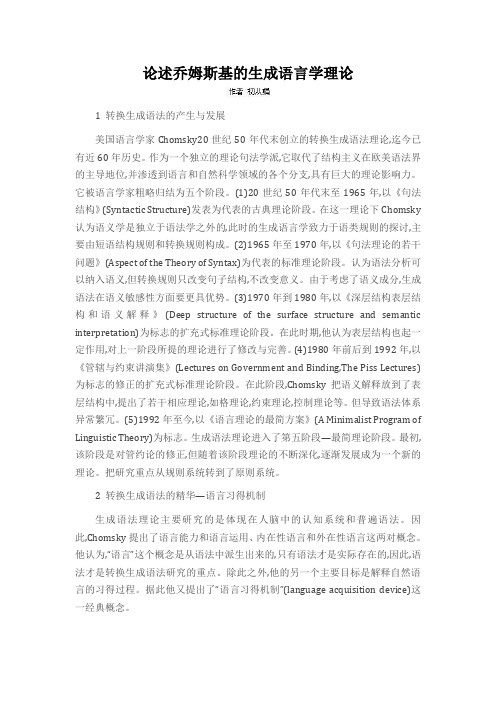
论述乔姆斯基的生成语言学理论1 转换生成语法的产生与发展美国语言学家Chomsky20世纪50年代末创立的转换生成语法理论,迄今已有近60年历史。
作为一个独立的理论句法学派,它取代了结构主义在欧美语法界的主导地位,并渗透到语言和自然科学领域的各个分支,具有巨大的理论影响力。
它被语言学家粗略归结为五个阶段。
(1)20世纪50年代末至1965年,以《句法结构》(Syntactic Structure)发表为代表的古典理论阶段。
在这一理论下Chomsky 认为语义学是独立于语法学之外的,此时的生成语言学致力于语类规则的探讨,主要由短语结构规则和转换规则构成。
(2)1965年至1970年,以《句法理论的若干问题》(Aspect of the Theory of Syntax)为代表的标准理论阶段。
认为语法分析可以纳入语义,但转换规则只改变句子结构,不改变意义。
由于考虑了语义成分,生成语法在语义敏感性方面要更具优势。
(3)1970年到1980年,以《深层结构表层结构和语义解释》(Deep structure of the surface structure and semantic interpretation)为标志的扩充式标准理论阶段。
在此时期,他认为表层结构也起一定作用,对上一阶段所提的理论进行了修改与完善。
(4)1980年前后到1992年,以《管辖与约束讲演集》(Lectures on Government and Binding,The Piss Lectures)为标志的修正的扩充式标准理论阶段。
在此阶段,Chomsky把语义解释放到了表层结构中,提出了若干相应理论,如格理论,约束理论,控制理论等。
但导致语法体系异常繁冗。
(5)1992年至今,以《语言理论的最简方案》(A Minimalist Program of Linguistic Theory)为标志。
生成语法理论进入了第五阶段—最简理论阶段。
乔姆斯基的转换生成语法理论[整理]
![乔姆斯基的转换生成语法理论[整理]](https://img.taocdn.com/s3/m/b79dd49403d276a20029bd64783e0912a2167c92.png)
乔姆斯基的转换生成语法理论无论是分析哲学还是欧洲大陆哲学,都重视研究语言,这是当代西方哲学的一个重要特征,语言不能脱离世界,语言只有表现世界才有它正真的存在。
当代美国语言大师乔姆斯基首创了转换生成语法理论,正是这种转换生成语法在语言中挑起了一场革命。
它标志着西方语言学的研究,尤其是美国的语言学界研究进入了一个崭新的时代,即乔姆斯基时期。
一、乔姆斯基“革命”乔姆斯基的转换生成语法所研究的不是语言现象,也不是人们的语言运用,而是人们的语言能力,这种做法是对当时美国占统治地位的布龙菲尔德的结构主义语言学理论的否定。
转换生成语法的创立,被认为是语言学中的一场革命,乔姆斯基的语言理论,很快成为现代语言学最有影响、最有活力的理论。
凡是希望跟上语言学当前发展的语言学专家,都重视乔氏理论.一批富有朝气的年轻人,在乔姆斯基周围,形成了转换生成语法学派。
这些学派由于基础理论与方法的新颖,而被公认为是与逻辑实证主义、日常语言学派相并列的现代西方语言哲学的又一个重要派别。
不仅如此,这场“乔姆斯基革命”还很快波及到语言学以外的许多学科,对于哲学、心理学、逻辑学、人工智能、通讯工程等都产生了很大影响。
因为人们认识到,人类与其他种类动物的明显区别,与其说是某种思维功能或智力,不如说是语言能力。
乔姆斯基的转换生成语法正是为了探究人的语言能力。
目的是为了对人类语言的某些最显著的特征做出数学般的精确描写。
二、转换生成语法的理论框架。
转换生成语法单纯从形式的角度来描写语法结构,在研究中采用数学和逻辑学的符号和公式等形式化的手段来研究语法。
乔姆斯基在语法研究过程中采用的是演绎法和内省法,其理论目标就是通过描述和分析语言结构和语言现象对语言使用者的语言能力作出充分解释,找出普遍语法,并进而探查人类所特有的内在语言习得机制,解释语言的生成和语言的创造性等问题。
本文仅谈及GB模型和MP模型。
GB模型是标志乔姆斯基理论成熟的模型,这个模型中他区分了语音形式PF(Phonetic Form)和逻辑形式MP(Logic Form),它们分别是同人脑主司发音的声音系统和思维认知系统的接口,叫语言模型的外模块性。
浅谈乔姆斯基的转换生成语法

乔姆斯基的转换生成语法一、转换生成语法的诞生及发展转换生成语法由美国学者诺姆·乔姆斯基于20 世纪50年代创建,以乔姆斯基1957 年发表的《句法结构》为标志发展至今已经有近60 年历史。
乔姆斯基的转换生成语法是语言学领域中的一次革命性变革,其影响力波及到语言学、心理学、哲学、教育学、逻辑学、翻译理论、通讯技术、计算机语言等领域,英国当代语言学家约翰·莱茵斯曾经作出这样的评论:“无论乔姆斯基的语法理论正确与否,它无疑是当前最有生命力、最有影响力的语法理论。
”转换生成语法理论的影响力可见一斑。
乔姆斯基师从美国描写语言学后布龙菲尔德学派的代表人物、著名语言学家海里斯,并在宾夕法尼亚大学攻读语言学、数学和哲学,获得哲学博士学位。
1957 年乔姆斯基的博士论文缩写而成的《句法结构》在荷兰出版,奠定了转换生成语法的理论基础。
转换生成语法发展至今经历了五个阶段:从1957 年转换生成语法诞生到1965 年为古典理论阶段,这一阶段的代表作是《句法结构》。
当时转换生成语法对当时美国流行的结构主义语言学提出了挑战,从研究方法到研究对象,转换生成语法对结构主义进行了全面颠覆。
在这一理论阶段,乔姆斯基认为语义学是独立于语法学之外存在的,合乎语法并不意味着必须要有意义,某些句子尽管没有意义,但是确实合乎语法规范。
第二个阶段是以1965 年出版的《语法理论的若干问题》为代表,这一阶段属于标准理论阶段。
在此阶段中,乔姆斯基开始将语义纳入语法范畴,并认为语义是由深层结构所决定的,因为如果不考虑语义,生成语法将产生大量无意义的句子,这些句子的存在无疑会降低生成语法的解释力和应用力。
所以在标准理论阶段,生成语法包括了三部分:句法部分,语义部分和语音部分。
其中句法部分是整个语法的核心。
由于考虑了语义成分,生成语法比起其他语法在语义敏感性方面要更具优势。
第三阶段从1972 年到1977 年,乔姆斯基的《深层结构、表层结构和语义解释》是从标准理论发展到扩充式标准理论的转折点。
乔姆斯基的语言学理论
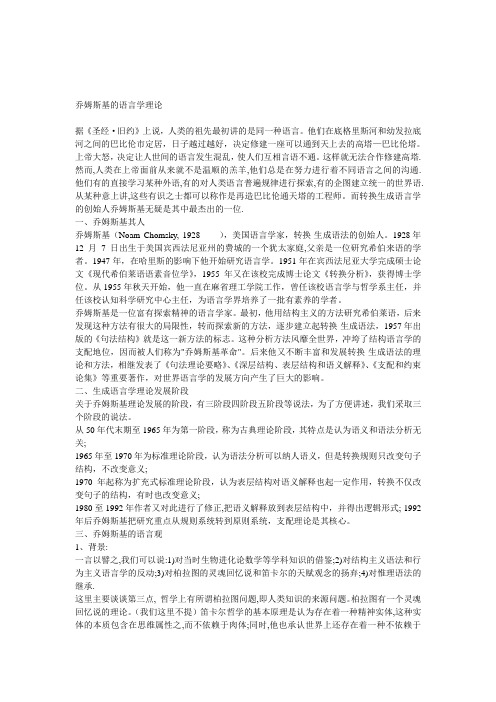
乔姆斯基的语言学理论据《圣经·旧约》上说,人类的祖先最初讲的是同一种语言。
他们在底格里斯河和幼发拉底河之间的巴比伦市定居,日子越过越好,决定修建一座可以通到天上去的高塔—巴比伦塔。
上帝大怒,决定让人世间的语言发生混乱,使人们互相言语不通。
这样就无法合作修建高塔.然而,人类在上帝面前从来就不是温顺的羔羊,他们总是在努力进行着不同语言之间的沟通.他们有的直接学习某种外语,有的对人类语言普遍规律进行探索,有的企图建立统一的世界语.从某种意上讲,这些有识之士都可以称作是再造巴比伦通天塔的工程师。
而转换生成语言学的创始人乔姆斯基无疑是其中最杰出的一位.一、乔姆斯基其人乔姆斯基(Noam Chomsky, 1928-- ),美国语言学家,转换-生成语法的创始人。
1928年12月7日出生于美国宾西法尼亚州的费城的一个犹太家庭,父亲是一位研究希伯来语的学者。
1947年,在哈里斯的影响下他开始研究语言学。
1951年在宾西法尼亚大学完成硕士论文《现代希伯莱语语素音位学》,1955年又在该校完成博士论文《转换分析》,获得博士学位。
从1955年秋天开始,他一直在麻省理工学院工作,曾任该校语言学与哲学系主任,并任该校认知科学研究中心主任,为语言学界培养了一批有素养的学者。
乔姆斯基是一位富有探索精神的语言学家。
最初,他用结构主义的方法研究希伯莱语,后来发现这种方法有很大的局限性,转而探索新的方法,逐步建立起转换-生成语法,1957年出版的《句法结构》就是这一新方法的标志。
这种分析方法风靡全世界,冲垮了结构语言学的支配地位,因而被人们称为"乔姆斯基革命"。
后来他又不断丰富和发展转换-生成语法的理论和方法,相继发表了《句法理论要略》、《深层结构、表层结构和语义解释》、《支配和约束论集》等重要著作,对世界语言学的发展方向产生了巨大的影响。
二、生成语言学理论发展阶段关于乔姆斯基理论发展的阶段,有三阶段四阶段五阶段等说法,为了方便讲述,我们采取三个阶段的说法。
乔姆斯基理论的五个阶段

乔姆斯基理论的五个阶段乔姆斯基坚持认为,语言机能内在于心智/大脑,对语言的研究是对心智的研究,最终是在抽象的水平上对大脑结构的研究。
因此,生成语法在学科归属上属于“认知心理学”,最终属于人类生物学。
它实际上应当叫做生物语言学,这是生成语法与其他任何传统的语言研究的根本区别。
认为研究语言能力就是为了建立一种反应语言能力的生成语法。
生成语法不是说话过程的模式,而是语言能力的模式,是对语言能力做出的形式化的描写,用一套公式将其内容表达出来。
生成语法不以具体语言的描写为归宿,而是以具体语言为出发点,探索出语言的普遍规律,最终弄清人的认知系统、思维规律和人的本质属性。
生成语言学思想最早萌芽于乔姆斯基1949年发表的本科论文《现代希伯来语的形态音位》。
乔姆斯基的语言理论在近三十年中多次经历修改,且当下仍在继续发展。
半个多世纪以来,生成语法大致经历了三个阶段,从20世纪50年代初到1965年为第一阶段,叫第一语言模式时期;从1965年到1970年为标准理论时期。
1970年以后,生成语法进入扩充式标准理论时期。
而国内教科书一般将1957年后的乔姆斯基理论分为如下的五个发展阶段:第一阶段:“第一语言模式”时期该时期的主要理论(生成转换规则)体现在《句法结构》一书中。
此时乔姆斯基对语法的定义为:“语法是一种工具,它能够生成并只能生成语言中所有合乎语法的序列”。
此外,乔姆斯基还提出“语法是自治的,独立于意义”。
乔姆斯基提出,转换生成语法的规则需要满足的条件有:1.生成性(generative):通过这些规则,能自动地生成符合语法的句子。
2.简易性(simple):简化一切可以简化的规则,达到用有限的规则生成无限的句子。
3.明确性(explicit):不许含糊不清,模棱两可。
4.形式化(formal):尽量避免用文字叙述规则,要用公式代替叙述。
5.详尽性(exhaustive):规则要尽量概括一切语言现象。
6.循环性(recursive):规则要能重复使用,才能生成无限的句子。
我们误解了乔姆斯基吗——《乔姆斯基》评述
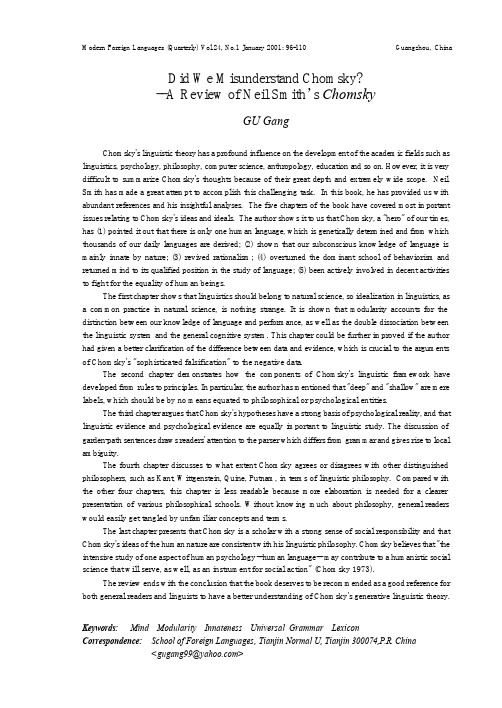
Modern Foreign Languages (Quarterly) Vol.24, No.1 January 2001: 96-110 Guangzhou, China Did We Misunderstand Chomsky?--A Review of Neil Smith’s ChomskyGU GangChomsky's linguistic theory has a profound influence on the development of the academic fields such as linguistics, psychology, philosophy, computer science, anthropology, education a nd so on. However, it is very difficult to summarize Chomsky's thoughts because of their great depth and extremely wide scope. Neil Smith has made a great attempt to accomplish this challenging task. In this book, he has provided us with abundant references and his insightful analyses. The five chapters of the book have covered most important issues relating to Chomsky's ideas and ideals. The author shows it to us that Chomsky, a "hero" of our times, has (1) pointed it out that there is only one human language, which is genetically determined and from which thousands of our daily languages are derived; (2) shown that our subconscious knowledge of language is mainly innate by nature; (3) revived rationalism; (4) overturned the dominant school of behaviorism and returned mind to its qualified position in the study of language; (5) been actively involved in decent activities to fight for the equality of human beings.The first chapter shows that linguistics should belong to natural science, so idealization in linguistics, as a common practice in natural science, is nothing strange. It is shown that modularity accounts for the distinction between our knowledge of language and performance, as well as the double dissociation between the linguistic system and the general cognitive system. This chapter could be further improved if the author had given a better clarification of the difference between data and evidence, which is crucial to the arguments of Chomsky's "sophisticated falsification" to the negative data.The second chapter demonstrates how the components of Chomsky's linguistic framework have developed from rules to principles. In particular, the author has mentioned that "deep" and "shallow" are mere labels, which should be by no means equated to philosophical or psychological entities.The third chapter argues that Chomsky's hypotheses have a strong basis of psychological reality, and that linguistic evidence and psychological evidence are equally important to linguistic study. The discussion of garden-path sentences draws readers' attention to the parser which differs from grammar and gives rise to local ambiguity.The fourth chapter discusses to what extent Chomsky agrees or disagrees with other distinguished philosophers, such as Kant, Wittgenstein, Quine, Putnam, in terms of linguistic philosophy. Compared with the other four chapters, this chapter is less readable because more elaboration is needed for a clearer presentation of various philosophical schools. Without knowing much about philosophy, general readers would easily get tangled by unfamiliar concepts and terms.The last chapter presents that Chomsky is a scholar with a strong sense of social responsibility and that Chomsky's ideas of the human nature are consistent with his linguistic philosophy. Chomsky believes that "the intensive study of one aspect of human psychology --human language-- may contribute to a humanistic social science that will serve, as well, as an instrument for social action" (Chomsky 1973).The review ends with the conclusion that the book deserves to be recommended as a good reference for both general readers and linguists to have a better understanding of Chomsky's generative linguistic theory.Keywords: Mind Modularity Innateness Universal Grammar Lexicon Correspondence:School of Foreign Languages, Tianjin Normal U, Tianjin 300074,P.R. China<gugang99@>中国・广州现代外语(季刊)第24卷2001年第1期(总第91期):96-110我们误解了乔姆斯基吗? 《乔姆斯基》评述*顾钢乔姆斯基的学说对语言学、心理学、哲学等众多学科的发展有重要影响。
人类语言的层次结构乔姆斯基

人类语言的层次结构乔姆斯基人类语言的层次结构乔姆斯基1. 介绍人类语言是人类最重要的交流工具之一。
通过语言,我们能够表达思想、分享知识、建立联系。
乔姆斯基(Noam Chomsky)是现代语言学领域的重要人物,他在20世纪的语言学理论中提出了一种关于人类语言的层次结构模型。
这个模型被称为乔姆斯基语法,它帮助我们理解语言的组成和语法的内部规则。
本文将深入探讨乔姆斯基语法的主要概念,以及它对我们理解人类语言的重要性。
2. 乔姆斯基语法的主要观点乔姆斯基语法的核心观点是,人类语言具有普遍语法结构,即所有人类语言都共享一些基本的语法规则。
这些规则被称为普遍语法原则,它们不是通过学习而获得的,而是与我们的大脑结构和基因相关联的。
乔姆斯基认为,这些普遍语法原则在人类语言的习得和使用中起着关键作用。
3. 乔姆斯基语法的层次结构乔姆斯基将语言的结构划分为不同的层次,分别是音素、词汇、句法和语义。
这些层次相互作用,构成了人类语言的层次结构。
3.1 音素层次音素是语言中的最小单位,它们是组成语言的声音元素。
每种语言都有一组特定的音素。
乔姆斯基认为,我们通过掌握不同的音素来区分不同的词语和句子,这是语言习得的第一步。
3.2 词汇层次词汇层次是语言的下一个层次。
它涉及到词汇的形成和组织方式。
我们通过学习词汇来理解和构建句子。
乔姆斯基认为,人类具有一种内在的能力,能够根据一些基础规则将词汇组织成无限多的句子。
3.3 句法层次句法层次是语言的核心层次,它关注句子的结构和语法规则。
通过句法规则,我们能够理解和产生各种各样的句子。
乔姆斯基认为,这种句法的能力是人类独有的,它是普遍语法原则的产物。
3.4 语义层次语义层次是语言的最高层次,它涉及到句子的意义和信息传递。
语义规则帮助我们理解和表达句子的意思。
乔姆斯基认为,语义规则也是由普遍语法原则所支配的。
4. 普遍语法原则的意义乔姆斯基的乔姆斯基语法对我们理解人类语言具有重要意义。
[转载]乔姆斯基(Noam
![[转载]乔姆斯基(Noam](https://img.taocdn.com/s3/m/420603f96394dd88d0d233d4b14e852458fb39b6.png)
[转载]乔姆斯基(Noam Chomsky)语⾔习得理论原⽂地址:乔姆斯基(Noam Chomsky)语⾔习得理论作者:FIVEHORSE乔姆斯基(Noam Chomsky, 1928--),美国语⾔学家,转换-⽣成语法的创始⼈。
1928年12⽉7⽇出⽣于美国宾⼣法尼亚州的费城。
1947年,在哈⾥斯的影响下他开始研究语⾔学。
1951年在宾⼣法尼亚⼤学完成硕⼠论⽂《现代希伯莱语语素⾳位学》,1955年⼜在该校完成博⼠论⽂《转换分析》,获得博⼠学位。
从1955年秋天开始,他⼀直在⿇省理⼯学院⼯作,曾任该校语⾔学与哲学系主任,并任该校认知科学研究中⼼主任,为语⾔学界培养了⼀批有素养的学者。
1 乔姆斯基的普遍语法理论 乔姆斯基在《语⾔与⼼智》⼀书中提出了“普遍语法”(Universal Grammar)的概念,以后简称为(UG)。
他假设⼉童⼀落⽣⼤脑⾥就存在⼀种独特的语⾔习得机制(Language AcquisitionDevice),以后简称LAD。
这种机制使得⼉童从周围听到有限的句⼦却能说出⽆限的句⼦。
他还提出⼀个语⾔习得的公式:最初的语⾔资料→LAD→语⾔能⼒。
乔姆斯基认为⼉童头脑中的LAD的主要组成部分是语⾔普遍特征,即普遍语法(UG)和⼀套评价系统。
⼉童听到外来语⾔后启动普遍语法,并在普遍语法的指导和控制下,在外来语⾔材料的基础上,通过假设——演绎的⽅法,在头脑中逐步形成有关母语的、系统的语法知识。
UG存在于⼈的⼤脑中,帮助⼈类习得语⾔,是⼈与⽣俱来的语⾔初始状态。
UG以第⼀语⾔习得速度快、知识准确、具有创造⼒等为依据研究第⼀语⾔。
乔姆斯基关于UG的假设为我们解释了为什么⼩孩⼦⼀⽣下来,⽤不了3-5年,不⽤接受系统的教育便已掌握了⾃⼰母语的主要特点。
UG是所有⼈类语⾔都遵循的⼀些共同原则和规则,但是如果语⾔知识仅仅是这些原则的话,那全世界的⼈就应该说同⼀种语⾔,但事实并⾮如此。
为了更合理的解释这⼀现象,就要应⽤到上⾯提到的评价系统。
现代汉语语法研究教程

现代汉语语法研究教程”陆俭明美国结构主义语言学派跟其他两个结构主义学派一样,也是从研究、分析、描写语音开始的,然后他们把从语音研究、分析所得来的一套方法推广到形态和句法的研究方面。
语音方面的成绩大,主要是从事音位分析、音位的理论研究,并对具体的语言进行音位分析。
音位(phpneme)的概念和音位学,正是由结构语言学派建立起来的。
音位概念的建立,把语音研究大大向前推进了一步。
这里我们着重介绍美国结构主义语言学派在语法,特别是在句法方面的研究思路。
美国结构主义语言学的研究,买你对未知语言的大量的语言材料,他们主要做这样的四步工作:一、运用国际音标采取如实记音的方法,尽可能记录大批语言资料。
二、分析这些语言资料,通过切分、语言单位同一性的认定,获得这个语言的不同层面上的单位,如音位、语素、单词、短语、小句、句子。
三、对每一个层面上的单位开出一个清单来,并分别考察他们的分布情况。
四、根据分布,对每一个层面上的单位进行分类。
在这四步工作中,除了运用国际音标记录语言资料之外,重要的手续是:切分(segmentation)、语言单位同一性的认定(identification)和分类(classification),而说运用的基本研究方法是替换分析法、对比分析法、分布分析法、直接组成成分分析法。
以上可以说是描写语言学研究语言的全部内容。
9.3 关于切分、语言单位同一性的认定、分类所谓切分,就是怎么把成段的话分割成一个个单位——从语法的角度说,分割到语素为止。
所谓语言单位同一性的认定,是说切分得到的两个或几个在形式甚至意义上相仿的单位是同一个语素呢,还是不同语素。
要做好切分和语言单位同一性的认定这两步工作,一是要采用替换分析法,一是要遵守“同一性”的原则。
替换(substitution)是描写语言学里最基本的一种分析方法。
所谓替换就是在一个语言组合里,一个语言项目替代另一个语言项目的过程。
举例来说,假“AB”这样一个组合,我们把B抽掉,填上C,而AC成立;或者我们把A抽掉,填上D,而DB成立,这一抽一填的过程就是替换。
乔姆斯基的三个levels of adequacy 的解释-概述说明以及解释

乔姆斯基的三个levels of adequacy 的解释-概述说明以及解释1.引言1.1 概述乔姆斯基的三个levels of adequacy是指他在语言学中提出的三个层次的解释。
这些层次分别是表层结构、深层结构和语义结构。
这些层次之间存在着紧密的联系,共同构成了语言的基本组成部分。
在语言学中,表层结构是最基本的层次。
它包括语言的音韵、形态和句法等方面。
表层结构是我们日常使用的语言形式,它使我们能够进行沟通和交流。
然而,表层结构只是语言的外在表现,不能完全揭示语言的内在含义。
深层结构是表层结构之下的一个层次,它包含了语言的意义和句子之间的逻辑关系。
深层结构反映了语言中隐藏的语义信息,例如句子的主题、论元和谓词结构等。
通过分析深层结构,我们可以更好地理解语言中的意思和含义。
最后,语义结构是最高层次的层次,它涉及语言的语义和语用方面。
语义结构是基于对深层结构的进一步分析和解释,它关注的是句子的真值和合理性。
通过对语义结构的研究,我们可以更深入地理解语言的意义和使用。
乔姆斯基的三个levels of adequacy为我们提供了一种系统化的方法来解释和理解语言。
这个理论框架不仅可以帮助我们更深入地探究语言的本质,还能为语言学研究提供重要的指导。
通过对表层结构、深层结构和语义结构的研究,我们可以更好地理解语言的运作机制,从而加深对语言的认识和理解。
1.2文章结构文章结构部分的内容可以按照如下方式撰写:文章结构:本文将按照以下结构进行论述和解释乔姆斯基的三个levels of adequacy。
首先,将在引言部分进行概述并明确文章的目的。
接下来,正文部分将包括两个主要要点的详细讨论。
第一个要点将探讨乔姆斯基的第一个level of adequacy,揭示其重要性和理论基础。
第二个要点将讨论乔姆斯基的第二个和第三个level of adequacy,探索其在语言学和认知科学中的应用和意义。
最后,在结论部分,将对第一个和第二个要点进行总结,并提出进一步研究的展望。
乔姆斯基语言学(下)

乔姆斯基语言学(下)第三部分转换生成语法的发展阶段(主讲人:陈倩)自从乔姆斯基在《句法结构》一书中公开提出转换生成语法以来,在此后的时间里乔姆斯基一直不断地修正发展自己的理论,到目前为止转换生成语言学理论已经经历了好几个发展阶段,关于这几个阶段的划分,有三阶段,四阶段和五阶段几种观点。
下面我们就看看这几种划分法:三阶段划分:(一)1957年—1965年经典理论阶段(二)1965年—1970年标准理论阶段(三)1970年—扩充式标准理论阶段五阶段划分:(一)1957年—1964年古典理论阶段(二)1965年—1971年标准理论阶段(三)1972年—1978年扩展标准理论阶段(四)1978年—1982年支配和约束理论阶段(五)1986年—经济核查理论阶段为了讲述方便,我们在这里采用四阶段划分法,如下:(一)1957年—1965年经典理论阶段(the classical theory)(二)1965年—1971年标准理论阶段(the standard theory)(三)1972年—1979年扩充式标准理论阶段(the extended standard theory)(四)1979年—管辖与约束理论阶段(the theory of government and binding)其实,这三种划分法在前两个阶段的时间划分上是一致的,只是有关七十年代后转换生成语法的发展阶段的划分有所不同,我们将前两种观点综合起来,把转换生成语法发展的四阶段重点介绍一下。
一.经典理论阶段(the classical theory)1957年乔姆斯基的著作《句法结构》(Syntactic structure)正式发表,是经典理论阶段的代表作。
书中首次阐明了转换生成语法的最初模型,我们称其为“经典理论”,也叫初期转化语法。
这一时期的转换生成语法的特点是:(1) 强调语言的生成能力。
他认为语法就像是一种装置,它应该能产生出所有合乎语法的句子,而不会产生不合乎语法的句子。
乔姆斯基的普遍语法再研究
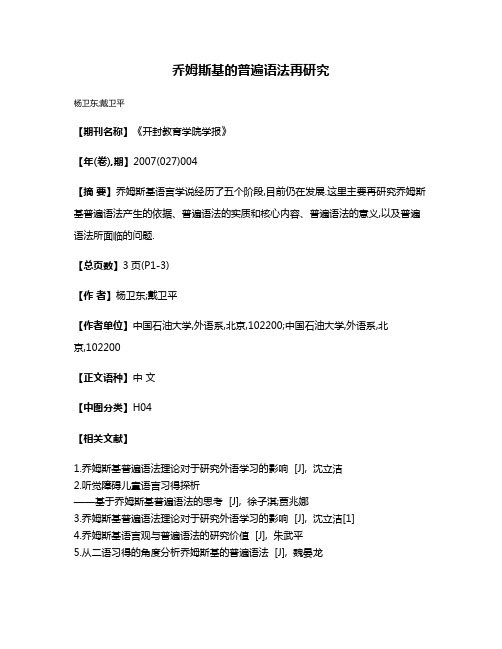
乔姆斯基的普遍语法再研究
杨卫东;戴卫平
【期刊名称】《开封教育学院学报》
【年(卷),期】2007(027)004
【摘要】乔姆斯基语言学说经历了五个阶段,目前仍在发展.这里主要再研究乔姆斯基普遍语法产生的依据、普遍语法的实质和核心内容、普遍语法的意义,以及普遍语法所面临的问题.
【总页数】3页(P1-3)
【作者】杨卫东;戴卫平
【作者单位】中国石油大学,外语系,北京,102200;中国石油大学,外语系,北
京,102200
【正文语种】中文
【中图分类】H04
【相关文献】
1.乔姆斯基普遍语法理论对于研究外语学习的影响 [J], 沈立洁
2.听觉障碍儿童语言习得探析
——基于乔姆斯基普遍语法的思考 [J], 徐子淇;贾兆娜
3.乔姆斯基普遍语法理论对于研究外语学习的影响 [J], 沈立洁[1]
4.乔姆斯基语言观与普遍语法的研究价值 [J], 朱武平
5.从二语习得的角度分析乔姆斯基的普遍语法 [J], 魏晏龙
因版权原因,仅展示原文概要,查看原文内容请购买。
_乔姆斯基理论_四十年发展概述

天津师大学报 1999年第4期“乔姆斯基理论”四十年发展概述顾 钢 摘 要 “乔姆斯基理论”是一门语言学界不可忽视的学说,它突显了研究内部语言的重要性,还对心理学、哲学等其他学科产生了很大影响。
本文概述了该理论四十年来的发展情况,重点介绍了该理论80年代以后采用的“管辖和约束”模式和90年代出现的“最简方案”模式。
关键词 乔姆斯基 普遍语法 转换生成语法 管辖与约束 移动 原则与参数 最简方案 1957年,美国麻省理工学院的青年教师乔姆斯基(N.Chom sky1928- )出版了《句法结构》一书,揭开了“乔姆斯基革命”的序幕。
这场“革命”打破了以观察归纳外部语言(E2L anguage)现象为主的传统语法研究的一统天下,突显了研究内部语言(I2 L anguage)的重要性,还对心理学、哲学等其他学科产生了很大影响。
称之为“乔姆斯基理论”,只是一种方便的提法,并不准确,因为这个理论是众多生成语法学家共同参与研究的结果。
但是,乔姆斯基对这个理论的影响是最大的。
一、乔姆斯基理论的基本假设和目标 乔姆斯基理论的基本假设是人脑中存在“普遍语法”(U n iversal Gramm ar),简称U G。
因此,乔姆斯基理论也被称为“普遍语法理论”。
根据乔姆斯基的看法,U G是一种语言知识,为人脑所固有。
它使儿童先天就具备在短时间内掌握母语的能力。
另一方面,U G也限定了人类各种语言的变化范围。
换句话说,纷繁复杂的各种语言结构,最终均可以用U G加以解释。
U G 的另一个重要特点是高度概括,极其明晰而又简洁。
它只生成所有合语法的句子,不生成不合语法的句子。
乔姆斯基理论致力于用内省(In tro sp ecti on)的演绎为主的方法推测出U G的具体内容,并用明晰(Exp licit)和形式化(Fo rm al)的方式加以表达。
原则的内容和参数的设定都必须符合儿童获得(A cqu ire)①母语的心理过程,以便能够回答儿童是怎样根据U G掌握一门具体的母语的问题。
- 1、下载文档前请自行甄别文档内容的完整性,平台不提供额外的编辑、内容补充、找答案等附加服务。
- 2、"仅部分预览"的文档,不可在线预览部分如存在完整性等问题,可反馈申请退款(可完整预览的文档不适用该条件!)。
- 3、如文档侵犯您的权益,请联系客服反馈,我们会尽快为您处理(人工客服工作时间:9:00-18:30)。
Chapter Three Major Developmental Phases of Chomsky's Linguistic TheorySince the turning out of his first book Syntactic Structure in which he formulated his transformational grammar, Chomsky has updated his extensively-applied linguistic notions with more lectures given and books issued. It is commonly recognized to be five phases.Phase One: Transformational GrammarIt is impossible to understand Chomsky’s linguistic notions without understanding his transformational grammar which is undoubtedly a milestone in the history of modern linguistics. Prior to the publication of Syntactic Structure in 1957, the linguistic study was mainly concerned with structuralism. Structural linguistics, with its insistence on objective methods of verification and precisely specified techniques of discovery, derives from the "behavioral sciences" approach to the study of man, and is also largely a consequence of the philosophical assumptions of logical positivism.During that period, most American linguists, according to Chomsky,defined the task of linguistics as “collecting language elements and classifying them”(Chomsky 1970:100). The approach was the mechanic procedure to find the language truth and discipline. Linguistics was a kind of verbal botany. Linguists at that time were just giving a description of a language by colleting data, colleting a large number of utterances of language. These utterances were always recorded on a tape recorder or in a phonetic script. The second step was to classify these elements of language at different linguistic levels, from the units of sounds, the phonemes, to the morphemes, then to the sequences of word classes. The study target was the rich language elements and structuralism was inductive with a word-grammar.However, with the language ability as the study target, TG aims to establish some theories, by means of which we can make sure which rules form the basis of language structure. The aim of linguistic theory was to provide the linguist with a set of rigorous methods, a set of discovery procedures which he would use to extract from the "corpus" the phonemes, the morphemes, and so on. Its approach is puttingforward hypothesis which is to be tested by native language speakers. Therefore, TG is a deductive language-category grammar which can explain infinite sentences with limited analyses.John R. Searle concludes that:Chomsky argued that since any language contains an infinite number of sentences, any "corpus," even if it contained as many sentences as there are in all the books of the Library of Congress, would still be trivially small. Instead of the appropriate subject matter of linguistics being a randomly or arbitrarily selected set of sentences, the proper object of study was the speaker's underlying knowledge of the language, his "linguistic competence" that enables him to produce and understand sentences he has never heard before.(Searle 1972: 29)Once the conception of the "corpus" as the subject matter is rejected, then the notion of mechanical procedures for discovering linguistic truths goes as well. Chomsky argues that no science has a mechanical procedure for discovering the truth anyway. Rather, what happens is that the scientist formulates hypotheses and tests them against evidence. Linguistics is no different: the linguist makes conjectures about linguistic facts and tests them against the evidence provided by native speakers of the language. He has in short a procedure for evaluating rival hypotheses, but no procedure for discovering true theories by mechanically processing evidence.The Transformational Grammar can be expressed in the following way:1 .Two levels of representation of the structure of sentences: an underlying, more abstract form, termed 'deep structure', and the actual form of the sentence produced, called 'surface structure'. Deep structure is represented in the form of a hierarchical tree diagram, or "phrase structure tree," depicting the abstract grammatical relationships between the words and phrases within a sentence.2. A system of formal rules specifying how deep structures are to be transformed into surface structures.Like a revolution, the transformational grammar established the basis for other subsequent theories of human grammatical knowledge. Since Chomsky's original presentation, many different theories have emerged. With the notion of a transformation remaining a central element in most models, concepts like deep structure and surface structure, phrase structure tree, phrase structure rules, verb phrase, noun phrase, creativity/ productivity became the grammatical elements in language study.Phase Two: Language Competence and Performance; Standard TheoryIn Aspects of the Theory of Syntax in 1965, Chomsky put forward two sets of concepts, which are now widely known. One is competence and performance and the other deep structure and surface structure. Chomsky defines competence as the ideal user's knowledge of the rules of his or her language, and performance the actual realization of this knowledge in linguistic communication.According to Chomsky,speakers have internalized a set of rules about their language. This rule system enables them to produce and understand an infinitely large number of sentences and recognize sentences that are ungrammatical and ambiguous. Chomsky holds that linguists should study the ideal speaker's competence, because the speaker's performance is too haphazard to be studied. Thus, the task of the linguists is to discover the speaker's internalized rules. Competence is independent from performance. The difference between them is like that between knowledge of language and use of that language. Although the investigation of competence is challenging because of the complexity of our knowledge of language, performance is observable. From this point, Chomsky began to look at language from a psychological point of view and consider linguistic competence as a property of the mind of a speaker.In order to explain the difference between "performance" (all sentences that an individual will ever use) and "competence" (all sentences that an individual can utter,but will not necessarily utter), Chomsky emphasizes the existence of some innate knowledge. Chomsky proves that the grammar of a natural language cannot be reduced to a finite-state automaton. He then argues for the existence of two levels of language: an underlying deep structure, which accounts for the fundamental syntactic relationships among language components, and a surface structure, which accounts for the sentences that are actually uttered, and which is generated by transformations of elements in the deep structure. Transformational analysis does overcome the limitations of phrase structure.Chomsky divides the knowledge of language into two components: a universal grammar, which is the knowledge of language possessed by every human, and a set of parameter values and a lexicon, which together constitute the knowledge of a particular language. On the whole, the various components of the grammar as articulated in Chomsky's Aspects of the Theory of Syntax (1965) are: the base component, transformational rules, the lexicon (the set of lexical items with syntactic, semantic, and phonological information), semantic interpretation rules, and the phonological component. Then comes the other distinctive feature of the second phase is the establishment of the Standard Theory, which defines a grammar as made of a syntactic component (phrase structure rules, lexicon and transformational component), a semantic component and a phonological component. The deep structure of a sentence is a tree (the phrase marker) that contains all the words that will appear in its surface structure.By including an account of the relation between sound and meaning in the construction of a grammar, Chomsky started coupling syntax and semantics. In this sense the "standard theory" syntax provides the mechanisms for transforming a meaning (a deep structure) into a phonetic representation (a surface structure).Phase Three: Extended Standard TheoryIn early transformational generative grammar, it was assumed that all semantic interpretation would be done off deep structure, but with the proposals for the extended standard theory (EST) of Chomsky came the realization that certain aspects of semantic interpretation, such as focus and presupposition and scope of quantifiers,must be done off surface structure. More recent developments suggest that EST did not go far enough. In Reflections on Language 1975, Chomsky made a good non-technical review of the EST and various philosophical issues related to generative grammar.In fact, the label 'Extended Standard Theory' was used for a while during the 1970's to describe a particular stage in the evolution of the framework. Over the next 15 years, the framework experienced great revision and changes.Phase Four: REST, GBBy the early 1980's a framework of syntactic theory had been developed, which became different enough to require a completely new presentation and a distinctive period.In 1980 Chomsky delivered a series of lectures at Pisa which were published in the subsequent year under the title 'Lectures on Government and Binding'. These lectures essentially presented the new framework for the first time in an organized, relatively coherent form. As a result, the title of the book was very swiftly given to the framework, which consequently is referred to by many as 'Government & Binding' or 'GB'. GB theory develops directly and without a radical break from earlier work in transformational generative grammar, in particular, from research that falls within the framework of the Extended Standard Theory.Government theory deals with the relationship between a syntactic head (e.g., a verb or preposition) and its dependents and binding theory, the relations among anaphors, pronominals, referring expressions, and their possible antecedents in sentences. 'Government & Binding' has been taken for the label 'Revised, Extended Standard Theory', often abbreviated 'REST'. Chomsky (1985) published Knowledge of Language: Its Nature, Origin and Use, in which the concepts of principles and parameters approach, typically abbreviated `P&P' or `PPA', took the place of former rules.The principle advantage of the Principle and Parameters framework lies in its potential for solving "Plato's Problem": how children can acquire their first language with such remarkable speed and efficiency. The principles do not generalize but the approach might be suggestive both in its achievements and apparent boundaries. Along with developments in other fields, especially immunology, it is regarded as a task of selection rather than that of instruction. The idea can be expressed like: everything is already laid out in the child's mind and the acquisition of knowledge lies in selecting particular choices from what has been laid out.Phase Five: Minimalist ProgramIn the 1990s Chomsky formulated a "Minimalist Program" in an attempt to simplify the symbolic representations of the language facility. The MP remains a version of the P&P model and thus enjoys the benefit of reducing the tension between descriptive and explanatory adequacy. Specific rules and constructions were being abstracted and subsumed under parameterised principles, which were then attributed to the initial state of the language faculty. In general, there are two aspects of this program: first, the minimisation of linguistic levels; second, the economy principles of derivation and representation.Although Chomsky's core ideas and their psychological implications have already formed during the first half of the 20th century, he never stops his revision of his own inventions. Minimalism is a manifestation of Chomsky's intellectual vigor in revision and regarded as the most radical of the periodic upheavals in his thinking.Although this paper have divided the development of Chomsky's language notions into the above five phases, it is no doubt that he has never stopped his devotion to language study and we also see the Post-Chomsky Linguistics which included three major tendencies. The first tendency is generative semantics, which motivates syntactic rules by means of semantic evidence. The second one is the upholding of the viewpoint like "Deep structures are universal" and "All languages have the same deep structure."A third tendency is the constantly increasing employment of the conceptual and terminological apparatus of modern formal logic and formal semantics.Chomsky Noam. Knowledge of Language: Its Nature, Origin, and Use. Westport: Greenwood Publishing Group, 1985.Searle John. Chomsky's Revolution in Linguistics. The New York Review of Books, 1972.Chomsky Noam, Syntactic Structure . Paris: Mouton & Co. N.V., Publishers, 1970.Chomsky Noam. Aspects of the Theory of Syntax. Massachusetts: The M.I.T. Press, 1965.。
